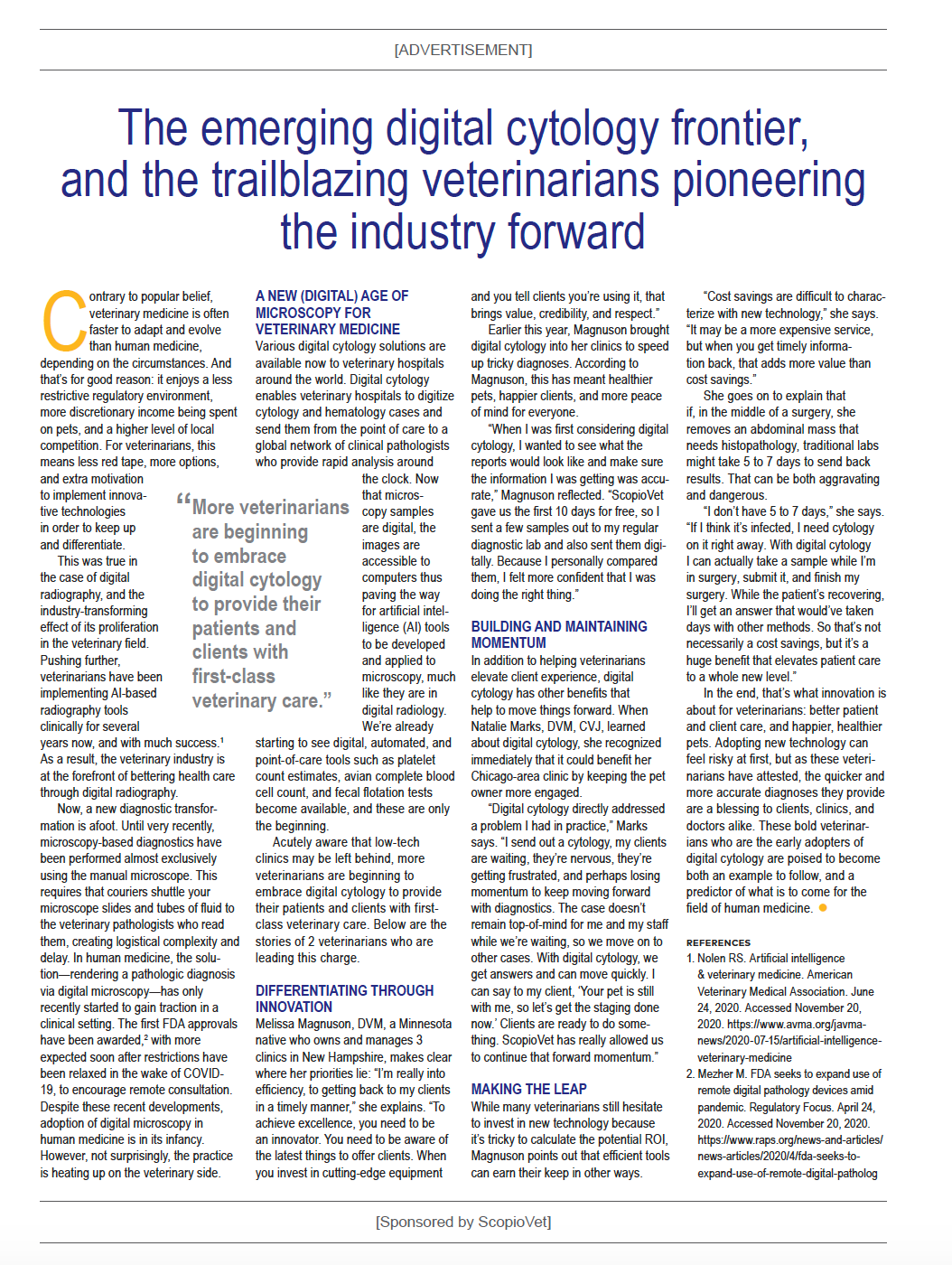
- dvm360 December 2020
- Volume 51
- Issue 12
The emerging digital cytology frontier, and the trailblazing veterinarians pioneering the industry forward
More veterinarians are beginning to embrace digital cytology to provide their patients and clients with first-class veterinary care. (Sponsored by ScopioVet)
Contrary to popular belief, veterinary medicine is often faster to adapt and evolve than human medicine, depending on the circumstances. And that’s for good reason: it enjoys a less restrictive regulatory environment, more discretionary income being spent on pets, and a higher level of local competition. For veterinarians, this means less red tape, more options, and extra motivation to implement innovative technologies in order to keep up and differentiate.
This was true in the case of digital radiography, and the industry-transforming effect of its proliferation in the veterinary field. Pushing further, veterinarians have been implementing AI-based radiography tools clinically for several years now, and with much success.1 As a result, the veterinary industry is at the forefront of bettering health care through digital radiography.
Now, a new diagnostic transformation is afoot. Until very recently, microscopy-based diagnostics have been performed almost exclusively using the manual microscope. This requires that couriers shuttle your microscope slides and tubes of fluid to the veterinary pathologists who read them, creating logistical complexity and delay. In human medicine, the solution—rendering a pathologic diagnosis via digital microscopy—has only recently started to gain traction in a clinical setting. The first FDA approvals have been awarded,2 with more expected soon after restrictions have been relaxed in the wake of COVID-19, to encourage remote consultation. Despite these recent developments, adoption of digital microscopy in human medicine is in its infancy. However, not surprisingly, the practice is heating up on the veterinary side.
A new (digital) age of microscopy for veterinary medicine
Various digital cytology solutions are available now to veterinary hospitals around the world. Digital cytology enables veterinary hospitals to digitize cytology and hematology cases and send them from the point of care to a global network of clinical pathologists who provide rapid analysis around the clock. Now that microscopy samples are digital, the images are accessible to computers, thus paving the way for artificial intelligence (AI) tools to be developed and applied to microscopy, much like they are in digital radiology. We’re already starting to see digital, automated, and point-of-care tools such as platelet count estimates, avian complete blood cell count, and fecal flotation tests become available, and these are only the beginning.
Acutely aware that low-tech clinics may be left behind, more veterinarians are beginning to embrace digital cytology to provide their patients and clients with first-class veterinary care. Below are the stories of 2 veterinarians who are leading this charge.
Differentiating through innovation
Melissa Magnuson, DVM, a Minnesota native who owns and manages 3 clinics in New Hampshire, makes clear where her priorities lie: “I’m really into efficiency, to getting back to my clients in a timely manner,” she explains. “To achieve excellence, you need to be an innovator. You need to be aware of the latest things to offer clients. When you invest in cutting-edge equipment and you tell clients you’re using it, that brings value, credibility, and respect.”
Earlier this year, Magnuson brought digital cytology into her clinics to speed up tricky diagnoses. According to Magnuson, this has meant healthier pets, happier clients, and more peace of mind for everyone.
“When I was first considering digital cytology, I wanted to see what the reports would look like and make sure the information I was getting was accurate,” Magnuson reflected. “ScopioVet gave us the first 10 days for free, so I sent a few samples out to my regular diagnostic lab and also sent them digitally. Because I personally compared them, I felt more confident that I was doing the right thing.”
Building and maintaining momentum
In addition to helping veterinarians elevate client experience, digital cytology has other benefits that help to move things forward. When Natalie Marks, DVM, CVJ, learned about digital cytology, she recognized immediately that it could benefit her Chicago-area clinic by keeping the pet owner more engaged.
“Digital cytology directly addressed a problem I had in practice,” Marks says. “I send out a cytology, my clients are waiting, they’re nervous, they’re getting frustrated, and perhaps losing momentum to keep moving forward with diagnostics. The case doesn’t remain top-of-mind for me and my staff while we’re waiting, so we move on to other cases. With digital cytology, we get answers and can move quickly. I can say to my client, ‘Your pet is still with me, so let’s get the staging done now.’ Clients are ready to do something. ScopioVet has really allowed us to continue that forward momentum.”
Making the leap
While many veterinarians still hesitate to invest in new technology because it’s tricky to calculate the potential ROI, Magnuson points out that efficient tools can earn their keep in other ways.
“Cost savings are difficult to characterize with new technology,” she says. “It may be a more expensive service, but when you get timely information back, that adds more value than cost savings.”
She goes on to explain that if, in the middle of a surgery, she removes an abdominal mass that needs histopathology, traditional labs might take 5 to 7 days to send back results. That can be both aggravating and dangerous.
“I don’t have 5 to 7 days,” she says. “If I think it’s infected, I need cytology on it right away. With digital cytology I can actually take a sample while I’m in surgery, submit it, and finish my surgery. While the patient’s recovering, I’ll get an answer that would’ve taken days with other methods. So that’s not necessarily a cost savings, but it’s a huge benefit that elevates patient care to a whole new level.”
In the end, that’s what innovation is about for veterinarians: better patient and client care, and happier, healthier pets. Adopting new technology can feel risky at first, but as these veterinarians have attested, the quicker and more accurate diagnoses they provide are a blessing to clients, clinics, and doctors alike. These bold veterinarians who are the early adopters of digital cytology are poised to become both an example to follow, and a predictor of what is to come for the field of human medicine.
References
- Nolen RS. Artificial intelligence & veterinary medicine. American Veterinary Medical Association. June 24, 2020. Accessed November 20, 2020. https://www.avma.org/javma-news/2020-07-15/artificial-intelligence-veterinary-medicine
- Mezher M. FDA seeks to expand use of remote digital pathology devices amid pandemic. Regulatory Focus. April 24, 2020. Accessed November 20, 2020. https://www.raps.org/news-and-articles/news-articles/2020/4/fda-seeks-to-expand-use-of-remote-digital-pathology
This article is sponsored by ScopioVet. To download, click the PDF below.
Articles in this issue
almost 5 years ago
Endoscopy and respiratory disease in horsesalmost 5 years ago
A few of our favorite things (2020 edition)almost 5 years ago
New data-driven insights help you prepare for a strong futurealmost 5 years ago
The doctor and the brickalmost 5 years ago
Bond Vet raises $17 million towards veterinary hospital expansionalmost 5 years ago
FDA approves weight loss management drug for cats with CKDalmost 5 years ago
Failing to meet their minimum environmental needs is killing catsalmost 5 years ago
Gastrointestinal motility disorders caused by esophageal diseasealmost 5 years ago
Licking wounds after pet euthanasiaalmost 5 years ago
Striving to pay it forwardNewsletter
From exam room tips to practice management insights, get trusted veterinary news delivered straight to your inbox—subscribe to dvm360.







